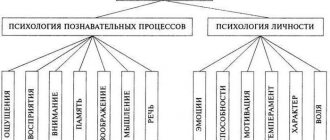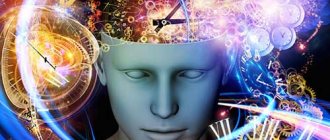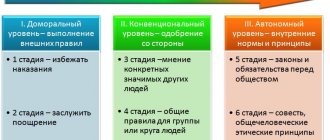Article:
Cognitive processes are the most important part of human activity.
Actually, a person is himself only insofar as he has developed mental cognitive processes. People with impaired or diminished cognition have long been considered inferior, and being labeled as mentally incompetent was considered the greatest shame—much more so than having any physical impairment. Over time, medical terms for mental disability or the diseases with which it is associated have moved beyond the boundaries of science and have become seriously offensive. This shows how much cognitive processes have been valued since ancient times.
Cognitive processes and their functions
The psyche, if we understand it as the content of our inner world, is a very complex formation. All mental phenomena are divided into 3 groups: processes, properties and states. True, this division is conditional, since everything that happens in our consciousness is interconnected. Attention and memory depend on the will, emotional states and motives, thinking influences the formation of needs, and images of the imagination can generate emotions no less strong than real phenomena. And all this is somehow connected with activity and accumulation of experience.
The place of cognitive processes in the human psyche
Despite the unity and interconnection of mental phenomena, several spheres can be distinguished, including cognitive, which includes the corresponding processes. They are also called cognitive (cognito – from Latin “knowledge”).
The content of the psyche is the result of a reflection of reality, its ideal, subjective image. Cognitive processes ensure the process of reflecting the world and forming ideal images in our minds. The level of their development determines the effectiveness of a person’s interaction with the outside world, as well as his mental and, in many ways, physical health. That is, problems associated with cognitive processes can make a person disabled, mentally retarded, or simply prevent him from adapting normally to the world.
Functions of cognitive processes
Cognitive processes are evolutionarily the “youngest” mental phenomena. Even the centers of these processes are located in the neocortex - the new cortex - the latest formation of our brain. The exception is the more ancient attention and memory, which are present even in fairly primitive living beings. But despite youth, cognitive processes perform important functions:
- Reception and differentiation of sensory information coming from the external world. In accordance with the channels of perception, all external signals are distributed between the visual, auditory, tactile, olfactory and taste analyzers.
- Processing primary information and creating holistic subjective images.
- Storage of received information.
- Establishing a connection between different areas of sensory experience, images, concepts, cognitive constructs, between new information and what is already available in experience.
- Creation of abstract concepts and signs, identification of patterns of external processes and phenomena. Using the sign function for communication (speech).
- Formation of behavior strategy and its motives.
- Goal setting, creation of long-term goals of activity.
- Prognostic function is the ability to foresee the results of activity and plan one’s behavior.
The totality of these functions of cognitive processes is usually called cognitive or mental abilities. The more efficiently these processes perform their functions, the higher the level of human intelligence.
Structure of cognitive processes
The cognitive sphere has a branched structure, which is associated with the complexity of the process of cognition of the world itself, which consists of several stages:
- obtaining information and primary data processing;
- analysis, comparison, synthesis and synthesis;
- remembering and storing information;
- creation of new knowledge in the form of images and concepts;
- complex operations with information at the highest level of consciousness and the formation of a cognitive strategy.
Human cognition has its own hierarchy, in which higher and lower levels of cognitive processes can be distinguished. The highest ones include the sensory-perceptual sphere, and the highest ones include thinking, imagination and the sign function, that is, speech. Along with this, there are two more cognitive processes that perform a servicing function and do not have their own content. This is attention and memory.
Manifestation
Cognitive activity is an ability that is difficult to develop and impossible to hide. By simply observing a child’s activities, you can determine how active he is and whether he strives for new knowledge. The presence of cognitive activity of preschoolers is shown by the following facts.
- The child is captivated by the activity, subject or story.
- He has a pronounced desire to complete a wide variety of, even complex, tasks; he does not want to stop and finish his actions.
- He shows independence, choosing means and methods of action, achieves the result himself and controls himself, this means that cognitive activity is at its best.
- When communicating with adults, he asks questions that satisfy his cognitive interest.
- He is very emotional about what he does.
The level, of course, varies greatly. The cognitive activity of preschoolers manifests itself differently in different children. If a child approaches his activities creatively, knows how to find non-standard solutions, thinks creatively, and uses previously acquired knowledge, this is a high level.
Sensory-perceptual sphere
This is the sphere of elementary cognitive processes, which include sensation and perception. On the one hand, they are the most ancient of all cognitive functions, on the other hand, they are the basis of knowledge of the world, as they ensure the entry of any information into the brain.
Feel
The various influences that the world has on a person are called signals; accordingly, the sense organs responsible for receiving these signals are receivers-receptors. Sensations are also called sensory processes (sensor - from English sensor, sensitive element). In sensations we reflect individual properties, qualities of objects, for example, color, sound, temperature, the nature of the surface, taste, etc. Sensations are fragmentary, since they do not provide a holistic picture of the world, and momentary, since they arise only at the moment of exposure to the stimulus. sense organ. The contact stopped and the sensation disappeared.
We are accustomed to thinking that there are five senses in accordance with the five main sensory channels through which information from the outside world enters the brain. These are hearing, vision, smell, touch (tactile sensations) and taste. Well, sometimes we can speculate about some mysterious sixth sense. In fact, there are much more than five types of sensations. In psychology they are divided into three groups.
- Extraceptive are exactly those five types of sensations that we all know. They arise from exposure to external stimuli and are associated with the work of receptors located on the surface of the body.
- Interaceptive or organic are the result of processing signals from our internal organs, for example, sensations of hunger, thirst, heartbeat, pain.
- Propriceptive sensations are associated with the work of receptors located in muscles and ligaments. They carry information about body position, movement (kinesthetic sensations), muscle tension, etc.
Along with these three groups, sometimes they consider separately, for example, vibration sensations - a very ancient type of mental phenomena, a kind of atavism. In the process of evolution, skin sensitivity and hearing developed from vibration sensations.
Despite the importance of sensations, we almost never deal with them in their pure form, or rather, we are rarely aware of them. For us, cognition begins with the emergence in the brain of a holistic image of a phenomenon. And another process is responsible for this – perception.
Perception
This cognitive process is also called perception and, accordingly, the processes associated with it are perceptual. Unlike sensations, perception is a reflection of the world in holistic images, although it is of a momentary nature. That is, we perceive, for example, a tree only while we see it. As soon as you turn away, the image of perception disappears. What remains? What is preserved in memory.
Just like sensation, perception is associated with the main sensory channels, so it is customary to talk about auditory, visual, olfactory, tactile and gustatory images. However, only the first two species have been more or less studied. And the rest have been less studied in psychology.
In addition to these five types of perception, there are several more:
- time perception;
- motion perception;
- perception of space.
True, the latter is related to visual images, but it has its own specifics and is of a slightly different nature than the formation of other visual images.
Perception is a more complex cognitive process than sensation. It is based on the analytical and synthetic activity of the brain, involves the activity of its various parts and has several stages or stages:
- exposure detection;
- discrimination is perception itself;
- identification - comparison with images in memory;
- identification – creation of a holistic image.
Perception is related to the activity and general mental state of a person. This connection is called apperception. In different emotional states, we perceive the same objects differently - this is familiar to all of us. And the richer a person’s sensory experience, the more images are stored in his memory, the richer and more varied his perception. He sees the nuances of the shades of clouds at sunset, notices the singing of birds even among the noise of the city, feels the coolness of the breeze and the aromas of a flowering meadow, in which he can identify the smells of different flowers.
Preschool period
This not too long period of time lays the foundation for the emerging personality and largely determines it. The family and society surrounding the child must create all conditions for the successful development of cognitive activity. The initial acquaintance with the surrounding reality occurs precisely in preschool childhood, therefore the attitude towards knowledge must be formed carefully but steadily: the cultural and historical experience of previous generations begins to be assimilated from very early childhood. The development of cognitive activity of preschoolers from the first days of life is the key to further successful education at school, institute, in scientific activities and in production.
Highest level of cognitive processes
Cognition does not end with the formation of images of perception. Even stored in memory, they are only building material for the highest level of cognitive processes, which includes thinking, imagination, creativity and speech activity.
Thinking
The thought process is also a reflection of reality. But unlike direct reflection in sensations and perceptions, thinking is mediated by generalized images and concepts. They are the tools with which a person processes and transforms information received by the brain. The result of thinking is the acquisition of new knowledge that was not present in sensory experience. Thinking is a complex activity; it is organized and controlled consciously. In psychology and logic (the science of thinking), several operations of mental activity are distinguished:
- analysis – comprehension of the received data, highlighting their individual significant elements, properties, qualities;
- comparison of individual details of various objects, phenomena, etc.;
- generalization - the creation of generalized images or concepts based on the identification of essential, significant features;
- synthesis - combining individual transformed elements of information into new combinations and obtaining theoretical knowledge.
Three main types of thinking reflect different aspects and levels of this cognitive process:
- Visual-effective thinking is the elementary level at which mental operations are performed in the process of objective activity.
- Visual-figurative thinking operates with images, both concrete and abstract.
- Abstract-logical (conceptual) is the highest level of thinking, the main tools of which are concepts, signs and symbols.
These types of thinking were formed gradually during the formation of man as a species, and in a child they also develop gradually. But in the cognitive activity of an adult, all three are present, becoming more active depending on the situation. In addition, it should be noted that although imaginative thinking is not considered the highest level, creativity - the pinnacle of the cognition process - is based precisely on the images that are born in our consciousness.
Imagination and creativity
Imagination is responsible for the birth of new images. This is an exclusively human form of cognition. If the rudiments of elementary thinking are found in higher animals, then imagination is inherent only to us.
Imagination is a complex mental process during which comparison, analysis and combination of elements of previous experience occur, and on the basis of such combinatorial activity unique images that are absent in reality are born. Even if we imagine something we have seen repeatedly, the picture in our brain will still differ from the original.
The level of originality and novelty of imaginative images can, of course, be different, so it is customary to distinguish between two types of imagination.
- The reproductive is responsible for recreating the elements of reality according to a given model. For example, we can imagine an animal from a description or an architectural structure from a drawing. How well the idea corresponds to reality depends on the strength of our imagination and the knowledge available in our memory.
- Creative imagination is the creation of original images, ideas, projects.
Imagination underlies the highest cognitive process - creativity. It is defined as the creation of something new. Unlike other cognitive processes, creativity occurs not only at the level of consciousness, but also in the sphere of practical activity. We can say that imagination becomes creativity when its images are embodied in reality - books and paintings are written, projects and unique works of art are created, inventions are made, buildings are built, etc.
It is creativity that brings to life the results of the cognitive process, and this is the basis for the development of human civilization.
Speech
We are accustomed to considering speech as a means of communication and do not think about its role in cognitive processes. And this role is quite a big one. Speech in cognition acts as a sign function of consciousness. The highest form of thinking - logical - occurs in speech form, its tools are words-concepts and other abstract signs.
Speech performs the function of organizing and stimulating thinking, so if a deaf-mute person is not taught a special language, then his mental abilities will remain at the level of a 3-4-year-old child.
Speech is even involved in the process of perception. In order to comprehend, “accept” a perceived object in our consciousness, we must name it, designate it. And in order to understand a complex problem and find its solution, you need to “speak” this problem, express the incomprehensible through words-signs. Such is the power of the word over our mind.
"The fascist flew by"
Elementary analysis in preschoolers is the starting point for a more complex, completely causal analysis, which examines the connections and dependencies between various signs of a particular phenomenon. In the eighth grade there was a regular lesson on speech culture. The teacher presented a reproduction of A. Plastov’s painting “The Fascist Flew” and asked to tell what the students saw in the painting. For some unknown reason, the class faded away. When the pause became unbearable, the very first excellent student raised her hand and said uncertainly: “The boy, apparently, is a Nazi. Most likely, something didn’t work out for him, it didn’t stick together, he was upset. He lies in khaki, in his berets, and cries. And the dog howls at him and takes pity on him.”
It is clear that modern children are completely victims of jargon. Who is a fascist for today's schoolchildren? Nationalist, skinhead. What action does the verb “fly by” now mean? I didn’t calculate, I made a mistake. Why did the cows lie down there? So who knows, they walk wherever they want. No one noticed the plane taking off. And the year the picture was created did not remind the children of anything. Although everyone answered the question about when the Great Patriotic War began. Cognitive activity in the classroom does not always bring the desired results. The students did not connect the information fragments together and did not synthesize them. Because they did not receive enough knowledge and skills in preschool age, when they should have been taught comparisons by contrast, by similarity, by similarity in elementary subjects.
Attention and memory
The process of cognition can be represented as a ladder, the ascent along which begins with sensations, then moves on to perception, thinking, imagination and ends at the top, which is creativity. But two cognitive processes stand apart. This is attention and memory. They play an auxiliary role and exist only in connection with other cognitive processes. But on the other hand, no intelligent human activity is possible without them.
Attention
This is the concentration of consciousness on external objects and phenomena or on internal processes. In order to perceive something, we must focus on it, and objects that do not fall into the sphere of attention are simply not noticed by us, that is, they are not included in the process of cognition.
There are two main types of attention: voluntary and involuntary.
- Involuntary attention occurs on its own, under the influence of specific stimuli. Such concentration, regardless of our desire, is caused by some strong, bright, unusual objects and phenomena, or those that matter to us and are associated with our interests and needs.
- Voluntary attention is a conscious activity aimed at maintaining concentration on objects that do not arouse interest. The significance of these objects is determined by the goals and objectives of the activity, and not by their brightness and unusualness. For example, to concentrate on a complex textbook text, you need to make an effort. Voluntary attention is often difficult, so it is necessary to develop conscious concentration skills.
In psychology, attention is considered both as a dynamic side of cognition and as its guide. It is this process that determines the selectivity of our consciousness, not only in terms of cognition, but also in mental activity in general. Attention is also associated with increased activity in various centers of the brain and makes any of our activities, including cognitive ones, effective and productive. And the loss of the ability to concentrate and concentrate, the involuntary loss of attention is a serious mental illness.








